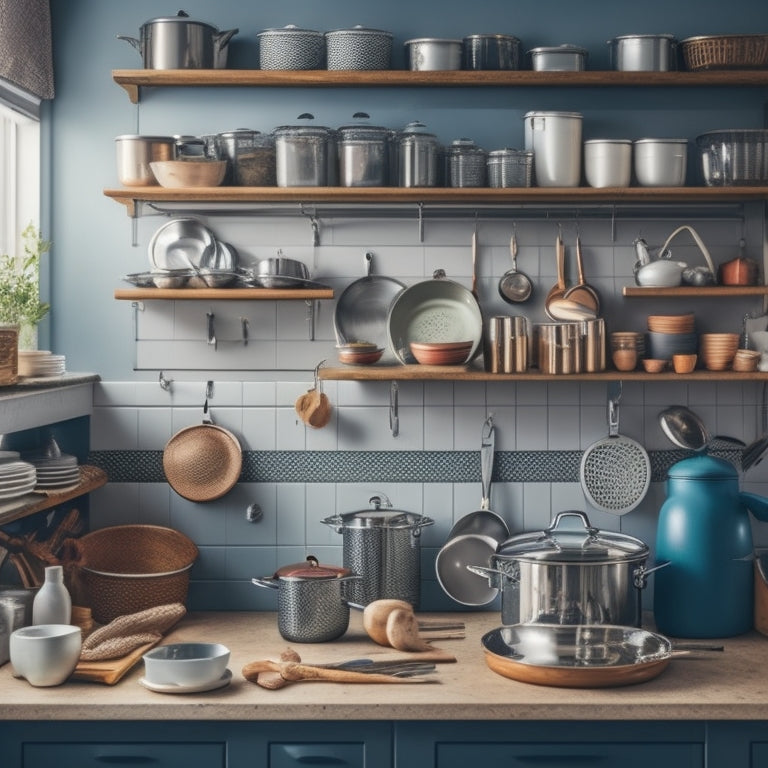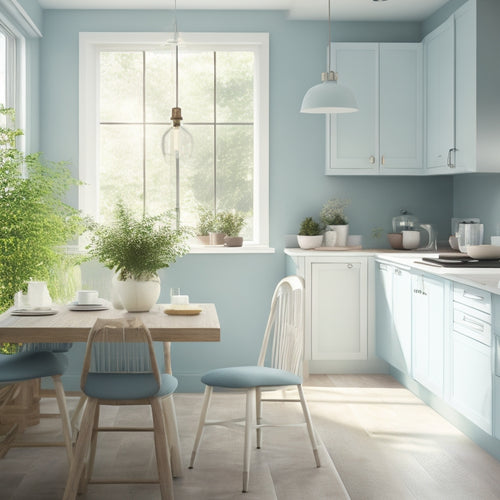
What's the Best Way to Store Heavy Cookware?
Share
When it comes to storing heavy cookware, maximizing vertical space is key. Hang pots and pans from ceiling-mounted racks or hooks to free up cabinet real estate and utilize often-overlooked overhead space. This creates a more organized and efficient kitchen, allowing for easy access to cookware while reducing clutter. Consider investing in a pot rack with hooks or a grid system to optimize storage capacity. By doing so, you'll optimize space in compact kitchens, improve kitchen organization, and keep cookware within easy reach. Now, take it to the next level by exploring customized storage solutions tailored to your kitchen's unique needs.
Key Takeaways
• Hang heavy cookware from ceiling-mounted racks or hooks to free up cabinet space and utilize overhead space.
• Invest in a pot rack with hooks or a grid system to create a more organized and efficient kitchen.
• Utilize adjustable shelves with customizable heights to ensure comfortable access and reduce strain on retrieving items.
• Maximize vertical space with wall-mounted racks that provide easy accessibility and add a decorative touch.
• Store cookware at convenient heights, use dividers or shelves for categorization, and label storage for quick identification and safety.
Maximizing Kitchen Vertical Space
Hang your heavy cookware from ceiling-mounted racks or hooks to maximize kitchen vertical space, freeing up valuable cabinet real estate and making the most of your kitchen's often-wasted overhead area. By utilizing this often-overlooked space, you'll create a more organized and efficient kitchen.
You'll appreciate the extra room for other essentials, and the visual appeal of your kitchen will improve dramatically.
When it comes to space saving solutions, consider investing in a pot rack with hooks or a grid system. These organizing options allow you to customize your storage to fit your specific needs.
For a more rustic look, opt for a wooden pot rack, or choose a sleek, modern design to match your kitchen's aesthetic. By taking advantage of your kitchen's vertical space, you'll be able to store more cookware while keeping your countertops and cabinets clutter-free.
Effective kitchen organization is all about finding the right storage solutions for your unique needs, and maximizing your kitchen's vertical space is a great place to start.
Heavy Cookware Storage Challenges
When you're dealing with heavy cookware, you're likely familiar with the frustration of trying to find a place to store it.
You're probably struggling with limited cabinet space, and you're not alone - it's a common issue many home cooks face.
What's more, the weight of your heavy cookware can cause damage to your cabinets, countertops, or other kitchen surfaces if not stored properly.
Limited Cabinet Space
Your kitchen's compact cabinet space can quickly become overwhelmed by the sheer bulk of heavy cookware, leaving you to wrestle with the dilemma of where to stash your prized possessions. This storage conundrum can be particularly frustrating when you're short on space. You need creative solutions to maximize your cabinet's real estate without sacrificing accessibility.
Here are a few strategies to help you optimize your cabinet space:
-
Utilize hanging hooks: Suspend pots and pans from the ceiling or a hook-mounted rack to free up shelf space.
-
Invest in stackable bins: Store lids, utensils, or smaller cookware items in labeled bins to keep them organized and out of the way.
-
Install pull-out drawers: Add slide-out drawers or shelves to make it easier to access heavy cookware without having to dig through cluttered cabinets.
- Employ under shelf baskets: Take advantage of the often-wasted space beneath your shelves by adding baskets or trays to store items like cookbooks, spices, or oils.
Weight Causes Damage
Storing heavy cookware improperly can lead to damaged cabinets, shelves, and countertops, as the weight of these items can cause warping, cracking, and even collapse over time. You might think you're saving space by stacking your heavy pots and pans, but you're actually putting your kitchen at risk.
When you pile heavy cookware on top of each other, you're concentrating the weight in one area, which can lead to structural damage.
To prevent damage, evenly distributing the weight of your heavy cookware is crucial. This means using sturdy shelves or storage units that are specifically designed to hold heavy items. Look for units with reinforced materials and a weight capacity that exceeds the total weight of your cookware.
Benefits of Vertical Storage
By opting for vertical storage, you can maximize your kitchen's available space and keep your heavy cookware organized, freeing up valuable real estate for other essentials. This space-saving solution is especially vital in kitchens where every inch counts.
With vertical storage, you can make the most of your kitchen's vertical space, keeping your cookware organized and within easy reach.
Here are some benefits of vertical storage:
-
Optimized space: By storing your cookware vertically, you can fit more items in a smaller footprint, perfect for compact kitchens.
-
Easy access: With your cookware stored vertically, you can quickly grab the pot or pan you need without having to dig through cluttered shelves.
-
Reduced clutter: Vertical storage keeps your cookware organized and out of the way, reducing clutter and making your kitchen feel more spacious.
- Improved kitchen organization: By utilizing vertical space, you can create a more streamlined kitchen organization system, making meal prep and cooking a breeze.
Choosing the Right Shelving
When choosing the right shelving for your heavy cookware, you'll want to ponder a few key factors to guarantee you're getting the most out of your storage solution.
You'll need to select a shelving material that can support the weight of your cookware, arrange the shelves in a way that maximizes storage space, and contemplate whether adjustable shelf heights will give you the flexibility you need.
Shelving Material Matters
Selecting the right shelving material is essential, as it directly affects the durability and weight capacity of your cookware storage system. You'll want to choose a material that can withstand the weight of your heaviest pots and pans, while also providing a sturdy and stable storage solution.
When deciding between metal vs. wood shelving, consider the following factors:
-
Durability: Metal shelving is often more durable and can hold heavier weights, while wood shelving may be more prone to scratches and dents.
-
Moisture resistance: If you plan to store cookware in a humid or damp area, metal shelving may be a better option due to its resistance to moisture.
-
Aesthetics: Wood shelving can add a touch of warmth and style to your kitchen, while metal shelving provides a sleek and modern look.
- Customization: Consider custom shelving options that cater to your specific cookware storage needs, such as adjustable shelves or specialized dividers.
Optimal Shelf Configuration
You'll need to think about the most suitable shelf arrangement to maximize storage capacity and accessibility, ensuring your heavy cookware is safely stowed away while still being easily retrievable.
For top-notch shelf organization, consider a space-saving design that utilizes vertical storage. This will allow you to store more cookware in a smaller footprint, making the most of your kitchen's real estate.
When organizing your shelves, place the heaviest or most frequently used items at the bottom for easy access. This will prevent you from having to dig through multiple layers of cookware to find what you need.
Additionally, consider the size and shape of your cookware when arranging your shelves. Group similar items together, such as all your pots or pans, and face them outward for easy identification.
Implementing these organizing tips will streamline your kitchen workflow and reduce clutter. By maximizing your shelf space, you'll be able to store more cookware without sacrificing accessibility, making cooking and cleaning a whole lot easier.
Adjustable Shelf Heights
Frequently, the key to successfully storing heavy cookware lies in choosing shelving with adjustable heights, allowing you to customize the storage space to fit your unique cookware collection. This feature is especially important when organizing pots and pans of varying sizes, as it enables you to maximize your storage capacity and keep your kitchen organized.
Here are some benefits of adjustable shelf heights:
-
Accommodate oversized cookware: Adjustable shelves can be customized to fit large, heavy pots and pans, ensuring they're stored safely and efficiently.
-
Optimize storage capacity: By adjusting shelf heights, you can create a more compact storage system that holds more cookware, making the most of your kitchen space.
-
Easy access: Adjustable shelves allow you to position your most frequently used cookware at a comfortable height, reducing strain and making it easier to retrieve what you need.
- Customize for your collection: With adjustable shelves, you can tailor your storage system to fit your specific cookware collection, ensuring each piece has a designated spot and is easily accessible.
Installing Adjustable Shelves
As you prepare to install adjustable shelves, measure the interior dimensions of your cabinet or pantry to guarantee a precise fit. This secures that your shelves will fit snugly and maximize the available space.
When choosing your shelves, consider customizable options that cater to your specific needs. Look for space-saving solutions that allow you to adjust the shelves to accommodate cookware of varying sizes.
To optimize kitchen efficiency, organize your cookware by frequency of use, with the most frequently used items at eye level. This saves you time and energy when searching for a particular pot or pan.
Additionally, consider the weight capacity of each shelf to secure that it can hold the weight of your heaviest cookware. By installing adjustable shelves, you'll be able to create a tailored storage system that streamlines your kitchen workflow.
With a little planning and attention to detail, you'll be able to create a cookware storage system that's both functional and efficient.
Utilizing Wall-Mounted Racks
By installing wall-mounted racks, you can efficiently utilize your kitchen's vertical space to hang heavy cookware, freeing up valuable cabinet and counter space for other essentials. This storage solution isn't only functional but also adds a touch of style to your kitchen.
Here are some benefits of utilizing wall-mounted racks:
-
Maximize Vertical Space: Make the most of your kitchen's walls by installing space saving racks that can hold multiple pieces of cookware.
-
Easy Accessibility: Hang your heavy cookware within easy reach, making it convenient to grab what you need while cooking.
-
Decorative Hooks: Add a decorative touch with stylish hooks that can hold pots, pans, and utensils, creating a visually appealing kitchen.
- Customization Options: Choose from a variety of wall-mounted racks that can be customized to fit your kitchen's unique layout and style.
Hanging Pots and Pans Effectively
When it comes to hanging pots and pans effectively, you'll want to start by grouping similar items together. This includes all your stainless steel pots or cast-iron skillets, to create a visually appealing and functional arrangement. This will make it easy to find what you need when you need it.
Next, consider installing ceiling hooks or pot racks to maximize your storage space. These will allow you to hang your cookware from the ceiling, freeing up wall space and keeping your pots and pans organized. For added convenience, look for organization racks with adjustable hooks that can accommodate pots and pans of varying sizes.
Maintaining Accessibility and Safety
You should make sure that your stored cookware is easily accessible to avoid straining or overreaching, which can lead to accidents and injuries. This is essential, especially when dealing with heavy cookware, as it can be hazardous to your safety. By maintaining accessibility, you'll be able to quickly grab the cookware you need, reducing the risk of accidents.
Here are some safety precautions and organization solutions to keep in mind:
-
Store cookware at a convenient height: Keep frequently used cookware at a height that allows you to easily access it without straining.
-
Utilize dividers or shelves: Separate cookware into categories and store them on shelves or in dividers to prevent clutter and make them easy to find.
-
Label your storage: Label each shelf or divider so you can quickly identify where each piece of cookware is stored.
- Keep heavy cookware near the floor: Store your heaviest cookware near the floor to prevent it from falling and causing injury.
Frequently Asked Questions
Can I Store Heavy Cookware in a Basement or Garage?
You can store heavy cookware in a basement or garage, but make sure you're providing adequate protection from moisture, pests, and extreme temperatures, and consider installing shelving or cabinets to keep items organized and accessible.
How Do I Prevent Water Spots on Stored Stainless Steel Cookware?
You might think stainless steel is rust-proof, but it's not; you'll still need to prevent rust. To prevent water spots, dry your stainless steel cookware thoroughly using a microfiber cloth and drying techniques like drying racks or silica gel packets.
Are There Cookware Storage Solutions for Corner Kitchen Spaces?
You'll find innovative corner kitchen solutions that maximize space, such as rotating carousels, swing-out racks, and wall-mounted shelves, offering space-saving options to efficiently store your heavy cookware in even the tightest corners.
Can I Store Cookware With Wooden or Silicone Handles in a Humid Environment?
Like a master chef, you carefully consider storing cookware with wooden or silicone handles in a humid environment, but beware: moisture can lead to rust, so guarantee rust prevention measures and proper ventilation to keep your prized possessions in top condition.
How Often Should I Clean and Maintain My Cookware Storage System?
You should set up a regular maintenance schedule to keep your cookware organization in check, cleaning your storage system every 1-2 months and performing deeper upkeep quarterly to prevent grime buildup and maintain peak performance.
Related Posts
-

Tiny Kitchen Decor Ideas to Boost Space
You can unveil the potential of your tiny kitchen by implementing clever decor ideas that enhance space and efficienc...
-

What Is a Smart Island for Home?
You're likely familiar with traditional kitchen islands, but a smart island for your home takes this concept to the n...

